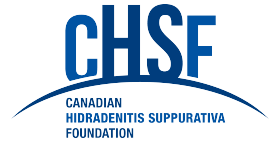Hidradenitis Suppurativa (HS) can significantly impact a person’s quality of life. Despite its prevalence, HS is often underdiagnosed and misunderstood, even in developed countries like Canada. Raising hidradenitis suppurativa awareness in Canada is crucial to ensure timely diagnosis, effective treatment, and improved support for those affected.

Hidradenitis Suppurativa Awareness: Challenges in Raising HS Awareness in Canada
Here are the challenges in raising HS awareness in Canada and strategies to overcome these challenges and improve support for the HS community.
1. Limited Public HS Awareness
The lack of public awareness about hidradenitis suppurativa in Canada is a significant obstacle to early diagnosis and appropriate treatment. Many Canadians are unaware of the condition, its symptoms, or its impact on the lives of those affected. This limited awareness can lead to delayed diagnosis, misdiagnosis, or underdiagnosis, resulting in individuals not receiving the care and support they need. Strategies to increase public awareness include:
- Developing and disseminating educational materials targeted at the general public, including pamphlets, posters, and online resources.
- Organizing HS awareness campaigns and events, such as workshops, webinars, and conferences, to engage the public and increase understanding of the condition.
- Collaborating with media outlets to share personal stories, research updates, and information about HS to reach a broader audience.
2. Stigma and Misconceptions
Hidradenitis Suppurativa is often associated with significant stigma and misconceptions, which can lead to social isolation and emotional distress for those affected. Misconceptions about the condition, such as associating it with poor hygiene, can contribute to the stigma and hinder efforts to raise awareness. To combat stigma and misconceptions, the following strategies can be employed:
- Encourage open dialogue about hidradenitis suppurativa, providing accurate information and debunking common myths.
- Share personal experiences and stories of those living with HS to humanize the condition and promote understanding.
- Collaborate with patient advocacy groups to create and promote awareness campaigns that challenge misconceptions and reduce stigma.
3. Insufficient Healthcare Provider Knowledge
Some healthcare professionals in Canada may not be familiar with hidradenitis suppurativa, resulting in delayed diagnosis, inadequate treatment, or a lack of referral to specialists. This lack of knowledge can significantly impact the quality of care and support provided to individuals living with HS. To address insufficient healthcare provider knowledge, consider the following strategies:
- Develop and distribute educational materials specifically targeted at healthcare professionals, such as diagnostic guides, treatment protocols, and referral pathways.
- Organize professional development opportunities, including conferences and workshops, to facilitate the sharing of knowledge and best practices among healthcare providers.
- Foster collaborations between primary care providers, dermatologists, and other specialists to improve referral networks and ensure comprehensive care for individuals with hidradenitis suppurativa.
These challenges in raising Hidradenitis Suppurativa awareness in Canada are significant but not insurmountable. By addressing limited public awareness, stigma and misconceptions, and insufficient healthcare provider knowledge, it is possible to create a more informed and supportive environment for Canadians living with hidradenitis suppurativa.
By implementing these strategies, individuals, healthcare professionals, and advocacy groups can work together to improve the diagnosis, treatment, and overall quality of life for those affected by this complex skin condition.



